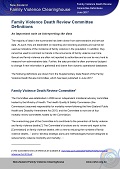
Definitions
Prepared by the New Zealand Family Violence Clearinghouse
University of Auckland, June 2017
Read online or download
For more information contact us
Downloads
Family Violence Death Review Committee definitions, June 2017 (PDF, 364 KB)
Family Violence Death Review Committee definitions, June 2017 (Word DOC, 318 KB)
Related documents
These definitions relate to Data Summaries.
Family Violence Death Review Committee definitions
An important note on interpreting the data
The majority of data in the summaries has been drawn from administrative and service data. As such, they are dependent on reporting and recording practices and cannot be used as indicators of the incidence of family violence in the population. In addition, they cannot be used to comment on trends in the occurrence of family violence over time. Sexual and family violence are often not reported to authorities and so can be very hard to measure from administrative data. Further, the data provided is often provisional (subject to change if new information is gathered) and drawn from dynamic operational databases.
The following definitions are drawn from the Supplementary Data Report of the Family Violence Death Review Committee, which has been published in June 2017.
Family Violence Death Review Committee[1]
The Committee was established in 2008 as an independent ministerial advisory committee hosted by the Ministry of Health. The Health Quality & Safety Commission (the Commission) assumed responsibility for mortality review following the New Zealand Public Health and Disability Amendment Act 2010, and the Committee is now one of four mortality review committees hosted by the Commission.
The overarching goal of the Committee is to contribute to the prevention of family violence and family violence deaths.[i] The Committee’s functions are to ‘review and report to the [Commission] on family violence deaths, with a view to reducing the numbers of family violence deaths…’ and to ‘develop strategic plans and methodologies that are designed to reduce family violence morbidity and mortality…’.
Members of the Committee are family violence experts from a wide range of disciplines across the social sector. They are selected on the basis of their potential to contribute to the mix of skills of the Committee and the background experience that they bring to the tables.[ii]
Definition of a family violence death[1]
The Committee’s terms of reference were modified in 2015, and the definition of a family violence death was updated to include a requirement that the death be an episode of family violence and/or that there be an identifiable history of family violence.
The purpose of this change was to exclude death events where the death itself was not an act of abuse or the culmination of a history of abuse; for example, where one of the parties accidentally killed a family member in the absence of any history of violence.
The Committee’s revised definition of a family violence death is (with revisions shown in bold text): The unnatural death of a person (adult or child) where the suspected perpetrator(s) is a family or extended family member, [iii] caregiver, [iv] intimate partner, pervious partner of the victim, or pervious partner of the victim’s current partner, and where the death was an episode of family violence and/or there is an identifiable history of family violence.
The following deaths are specifically excluded from the definition of a family violence death: the death of non-family member bystanders or interveners in a family violence episode; suicides; assisted suicides; and deaths from chronic illness associated with family violence.
Footnotes
[i] The Committee’s terms of reference are available at: www.hqsc.govt.nz/assets/FVDRC/FVDRC-terms-of-reference-Oct-2015.pdf
[ii] See Appendix 3 for a list of past and current members in the Supplementary Data Report: January 2009 to December 2015.
[1] Family Violence Death Review Committee. (2017). Fifth Annual Report: January 2009 to December 2015. Wellington: Family Violence Death Review Committee. Retrieved 20 June 2017.


